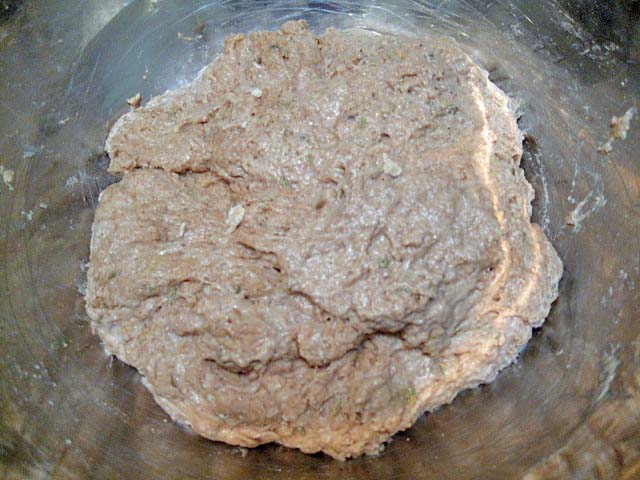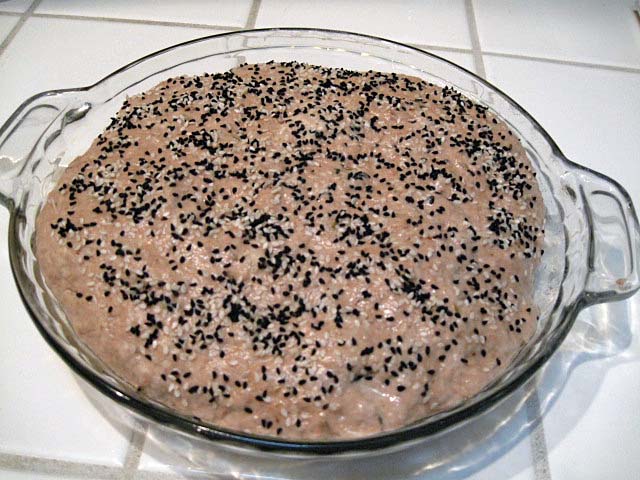
Artos - Greek Saints' Day Bread from Kassos

Artos - Greek Saints' Day Bread from Kassos crumb
“Artos” is the ancient Greek word for leavened bread. (“Psomi” is the modern Greek word.) However, “Artos” has come to refer more specifically to various enriched celebration breads, particularly those baked for Easter.
I found the recipe for this version of “Artos – Greek Saints' Day Bread” in Savory Baking from the Mediterranean, by Anissa Helou (Harper-Collins, NY, 2007). This is a lovely and quite comprehensive book. Unlike many cookbooks covering ethnic cuisines, it does not seem to be “dumbed down.” There are no ingredient substitutions, and the original techniques for mixing, fermentation, shaping and baking are given. Well, the author does give instructions for American/European home ovens, whereas many of the items in the book are authentically baked in wood-fired ovens or tandoors or the like.
Helou tells us that she found this bread while visiting the island of Kassos which is a small island at the southern end of the dodekanese chain. There, it is baked for many saints' days. It is baked at home, then taken to the church to be blessed by the priest before being cut and shared with the congregation at the end of mass.
Helou recommends this version of Artos for breakfast or tea with Greek-style yogurt and honey or with “very good butter.” She also says this bread makes delicious toast.
The recipe is similar to others I've seen for Artos in that it is spiced, but it is less enriched than most and is very simply shaped. The technique of baking in a 9 inch pan is one I've seen for other Greek breads but never tried before. Helou provides all her measurements in volume, and that's how I made the recipe.
Artos: Greek Saints' Day Bread
Ingredients
4 ½ tsp (2 packages) active dry yeast. (I used 2 tsp instant yeast.)
3 1/3 cups AP flour, plus extra for kneading and shaping.
1 ½ tsp kosher salt or sea salt.
2/3 cup sugar. (I wonder why not honey?)
1 T ground cinnamon.
1 tsp ground cloves.
2 T anise seeds (I substituted fennel seeds, not having anise seeds on hand.)
2 T EVOO, plus extra for greasing the baking dish.
1 ¼ cup of warm water.
2 T red wine.
1 ½ T white sesame seeds
1 ½ T nigella sees (optional)
Procedure
-
If using ADY, dissolve it in ½ cup warm water and stir. (I just mixed the instant yeast with the dry ingredients.)
-
Combine the flour, salt, sugar, cinnamon, cloves and anise seed (and instant yeast, if used) in a large bowl and make a well in the center.
-
Add the olive oil and, with fingertips, rub the oil into the flour until well incorporated.
-
Add the wine and water (the yeast water plus ¾ cup or, if instant yeast was used, all the 1 ¼ cups). Mix to make a sticky dough.
-
Spread 2 T water over the surface of the dough. (I did this, but think 1 T would have been plenty.) Cover the bowl and allow to ferment for 1 hour.
-
Grease a 9-inch round deep baking dish with olive oil. Sprinkle half the seeds over the bottom of the dish.
-
Transfer the dough to a well-floured board. With wet hands, fold the edges of the dough to the center to make a round loaf. Wash and dry your hands, then transfer the loaf to the baking dish, seam side down. (I used one hand and a bench knife for the transfer.)
-
Gently pat the loaf to spread it evenly in the dish. Wet your hands and spread more water over the top of the dough. Sprinkle the rest of the seeds all over the top.
-
Cover with plasti-crap and proof until doubled in volume. (I proofed in a warmed microwave oven for 75 minutes.
-
Pre-heat the oven to 400ºF.
-
Uncover the bread and place in the oven (in the baking dish). Bake for 20 minutes, then turn down the oven to 350ºF and bake for another 30 minutes, or until golden brown all over.
-
Turn the loaf onto a cooling rack and cool thoroughly.
-
Serve when cooled or wrap in a kitchen town. It will keep up to two days.

Dough, mixed

Proofing in Pyrex baking dish

Artos, proofed and ready to bake
The bread gave off a most powerful, exotic aroma while baking and cooling. The cloves and nigella aromas were most potent, to my nose. When sliced, the crust was crisp. The crumb was soft and tender. The flavor was very spicy and very exotic. In my limited experience of spiced breads, it was closest to a French pain d'epice, but different because of the fennel and nigella flavors. I enjoyed it, but I don't think I could eat a lot of it at a time. I'm looking forward to trying it toasted and with some Greek yogurt, as recommended.
David
Submitted to YeastSpotting
- dmsnyder's Blog
- Log in or register to post comments
I was looking for Rye in the contents.. untill i saw the spices and the wine.. the color looks just right.. Interesting Bake, David!
Hello David, That bread sounds like it has some great flavor.
(BTW, did you ever find your Vin Santo?)
Regarding the book, you note "There are no ingredient substitutions", but when I read the list of ingredients the first thing I thought was "I wonder if using Vin Santo in place of the red wine would be good!"
:^) from breadsong
I forgot to look for it last trip to my wine shop.
Anyway, I'd need to bake another batch of biscotti to eat with it. Not a problem.
David
but I can imagine the spices were overpowering! I haven't tasted Nigella, yet, but the amounts of cloves, cinnamon and anise (or fennel) per quantity of flour seem really huge.
Karin
You are correct, the spices were rather over-powering. I really think this bread must be meant to be eaten in small quantities with something else to temper the strong flavor.
This was the first time I'd used nigella. It has a rather strong flavor - kind of in the onion family. The aroma of the bread was somewhat reminiscent of curry, and I think this was due to nigella.
David
What an interesting combination of spices. I can imaging it will mellow out after a day or so. Thanks for sharing this ethnic loaf with us. What was you DIL's take on it?
Eric
I just tasted the loaf, then froze it. I may try it this weekend.
Stephanie just saw the photos, of course. Her e-mail comment was "beautiful." We haven't been able to talk about it yet.
David
I was looking for something entirely different but landed here . I ve sampled this bread in Kasos so here is the story behind it..... In its original form this is a "koylouri" , a bagel shaped bread stick.
Whole wheat flour. Baked twice, first on 230C and then 120C low and slow.
Anise, cloves, cinnamon and pepper (or nigela seeds , aka black cumin) were used to make the bread taste sweeter than the amount of sugar it contained. Sugar used to be expensive and this is a very very old recipe.
It was paired with Greek/Turkish coffee, maybe some wild tea and/or some cheese (most probably fresh cheese like anthotyro (ricotta) or a mixture of fresh cheese and milk , feta was not readily available back then)
It greatly differs from the usual bland rusk/coulouri from Crete and the only reason i can think of is how Kasos natives were so close to the Asia Minor peninsula and the Middle Eastern influences that entailed .